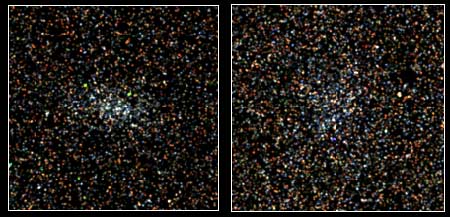‘
What are those two images? Not much to look at, are they?
Appearances can be deceiving. Astronomers are actually pretty excited about these two guys. They are dwarf galaxies, collections of stars that are like our own Milky Way Galaxy, but far smaller. The Milky Way has about 200 or so billion stars in it. These two dwarfs only have about 100,000 stars in them (which is why they are called dwarf galaxies of course). They appear to be companions to the Milky Way, orbiting it at a distance of a little over 600,000 light years. For comparing, the Milky Way is about 100,000 light years across.
Why is this exciting? We already know of several galaxies orbiting our own, like moons orbiting a planet. But so far, they have all been more massive, closer, and brighter than these two punks. These two (which are not yet officially named) are the most distant known, which helps astronomers understand how the Milky Way formed, and what it’s made of. Theories suggest that there might be a hundred satellites like these, but they are so faint they are really hard to find. Any time one is discovered, it’s a big deal.
These two were found in the Sloan Digital Sky Survey – a project to map out a quarter of the sky with incredible precision: they’ll map 100 million celestial objects, and determine distances to a million galaxies. An astronomer noticed the one on the left as a slight over-dense cluster of stars in the constellation Canes Venatici. He emailed an astronomer friend who started looking at the data, and found the second galaxy a few hours later!
This makes me wonder just how many more of these things are floating out there. With projects like Sloan going on, we’ll be finding many more such treasures, sitting in our own back yard.’